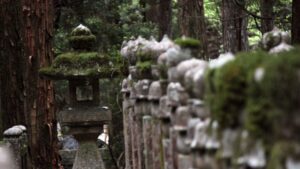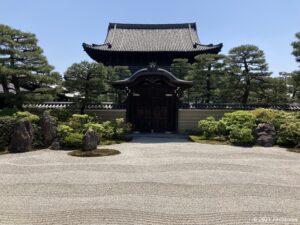Itsukushima Shrine, Itsukushima Detiy smiled on Samurai, Mori Motonari
Itsukushima Shrine - UNESCO World Cultural Heritage site - seemingly floating on the water, enchants visitors with the atmosphere of its spiritual power in the vermillion-lacquered shrine. It’s located on Miyajima Island in Hiroshima prefecture, traveling just 10 minutes by ferry from the port. Miyajima Island has been adored as “the island where deity resides” since ancient days. The main building and worship hall stages are connected and surrounded by the east and west corridors situated symmetrically to each other which are 240 meters in length and reflected in total by the blue ocean and sky. A large vermillion gate on the sea is a symbol of the Itsukushima Shrine. It was established in 593 and renovated to the advanced beautiful Shinden-zukuri architecture style (a noble's residence style in the Heian period) around 1170 by a powerful Samurai, Taira Kiyomori, who was the first Samurai appointed as a chief minister.
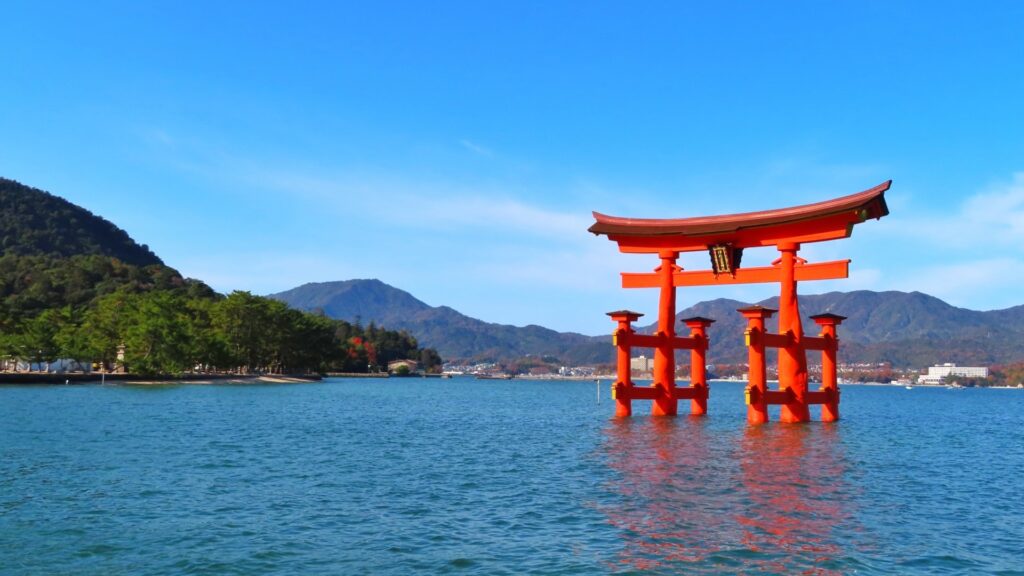
The Deity of Victory smiles on Motonari at the Itsukushima Battle
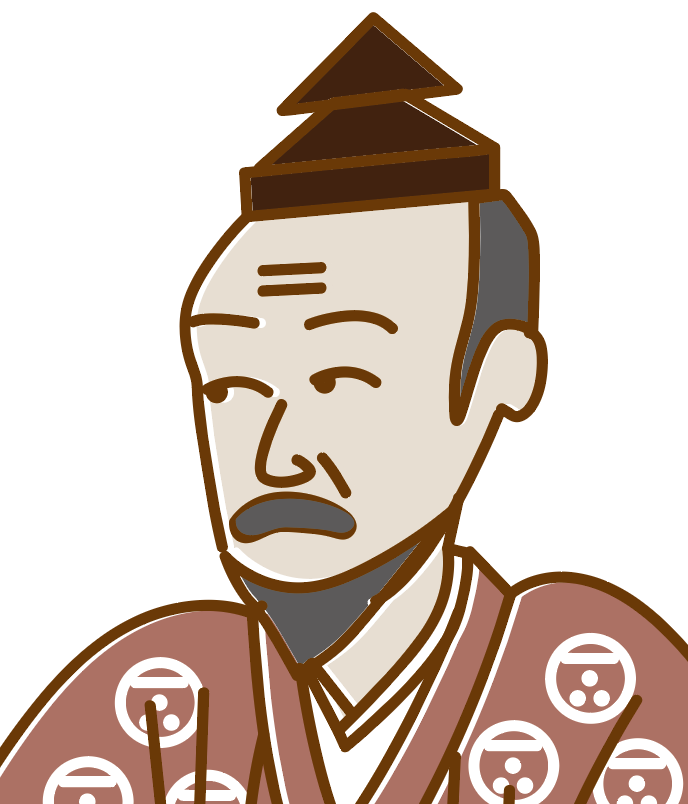
Here, on this holy island, the Itsukushima Battle occurred in 1555, known as one of three surprise attacks in Japan (Itsukushima, Okehazama, and Kawagoe) during the age of Gekokujo (the revolt of vassals against their lords). Mori Motonari (1497-1571, 毛利元就) at the age of 59 succeeded in defeating an enemy, Sue Takafusa (1521-1555, 陶隆房) with the best of his lethal attack and intelligence. The Mori clan was a minor feudal lord in Hiroshima and had wedged and swung like a pendulum between the two major powers in western Japan, the Ouchi and Amago clans. This victory brought Motonari the foundation for his achievement in ruling the whole of western Japan, and he subsequently became the most powerful feudal lord in this area. It was the middle of the Warring States period. He was a fairly smart warlord, and his wisdom, courage, and the blessings of the Itsukushima deity brought Motonari victory.
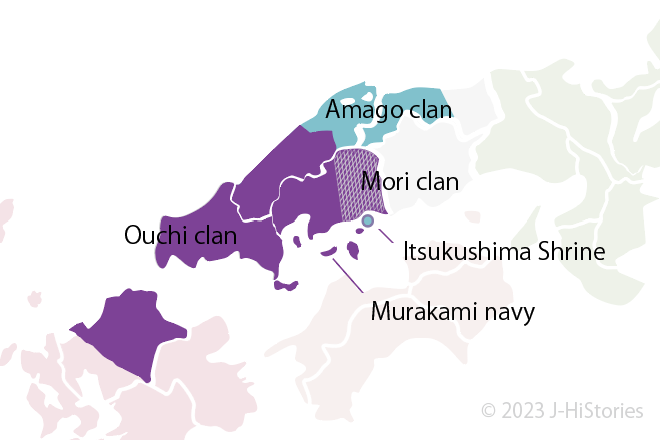
Moronari Faces An Overwhelmingly Unfavorable Battle

The conflict began with Sue’s rebellion against his lord, Ouchi Yoshitaka (1507-1551, 大内義隆) in 1551. Motonari, who was a vassal of Ouchi, did not immediately raise an army to confront Sue and instead chose to monitor the situation. Meanwhile, another vassal of Ouchi, Yoshimi Masayori, raised an army to suppress Sue's rebellion. Motonari was requested by both Sue and Yoshimi to support. After careful consideration, Motonari decided to support Yoshimi's army, despite the risk that the Mori clan might be destroyed if they lost the battle. Motonari also believed that if he could defeat Sue's much larger army (which consisted of about 25,000 warriors and 500 boats) with his own forces (consisting of only 4,000 warriors and approximately 60-70 boats, supported by the Murakami Navy), he could achieve hegemony in the western region.
Moronari's double and triple scenarios of conspiracy to win
- Firstly, Motonari tried to get Sue’s trusted chief, Era, to betray Sue. Of course, it was ignored by them. But Motonari concurrently spread the rumor that Era betrays Sue in their territory. Finally, Sue lost his confidence in Era and killed him after Motonari’s repeated conspiracies this way and that way. Motonari succeeded in making Sue lose his key vassal.
- Secondly, Motonari selected Itsukushima as the place of surprise attack, a very small island suitable for ambushing Sue’s more significant force of warriors. Motonari believed that Sue must try to seize the island if Motonari built his castle on it because (1) Itsukushima is located very close to Sue’s military site and (2) it’s a holy island highly respected by Sue. According to a plan, Motonari built a new “Miyanoo castle” there.
- Thirdly, Motonari requested only one day of help from the most powerful Murakami’s navy power, though Sue also asked Murakami for support. Murakami supported Motonari because his request for only “one day” full of spirit made it more convincing to win. Murakami boats appeared at the very moment that Motonari ordered his warriors to sail to Itsukushima Island.
The Blessing Brought Motonari Victory
On September 22, as Motonari had planned, Sue landed on Itsukushima Island. On September 30th, Motonari divided his forces in two; (1) The main force took advantage of the cover of night to head for Itsukushima, secretly landed on the eastern shore, crossed the mountains, and marched to the rear of Miyanoo Castle, and (2) the other one sailed to the front island close to the castle. For a while, they waited for Murakami’s navies to arrive. After waiting and waiting, a large fleet of 200 boats appeared from beyond the sea. The next early morning, Motonari's forces started the all-out attack on Sue from behind, and the Murakami navy, which was waiting offshore, burned down the ships of the Sue Navy one after another. Sue’s 20,000 warriors were unable to move freely due to being forced into a narrow space and were defeated one after another. As the fierce battle continued, Sue was finally pushed to the edge and killed himself. Here, the Itsukushima battle ended. It was probably the blessing of the Itsukushima Deity that the Sue forces, caught off guard by bad weather the night before fighting, were able to defeat them. After the war, Motonari buried Sue’s warrior dead bodies in the ground respectfully, scraped and threw the bloodied dirt into the sea, washed the Itsukushima shrine’s building, and prayed for the warrior’s souls by dedicating Kagura (Shinto sacred songs and dances).
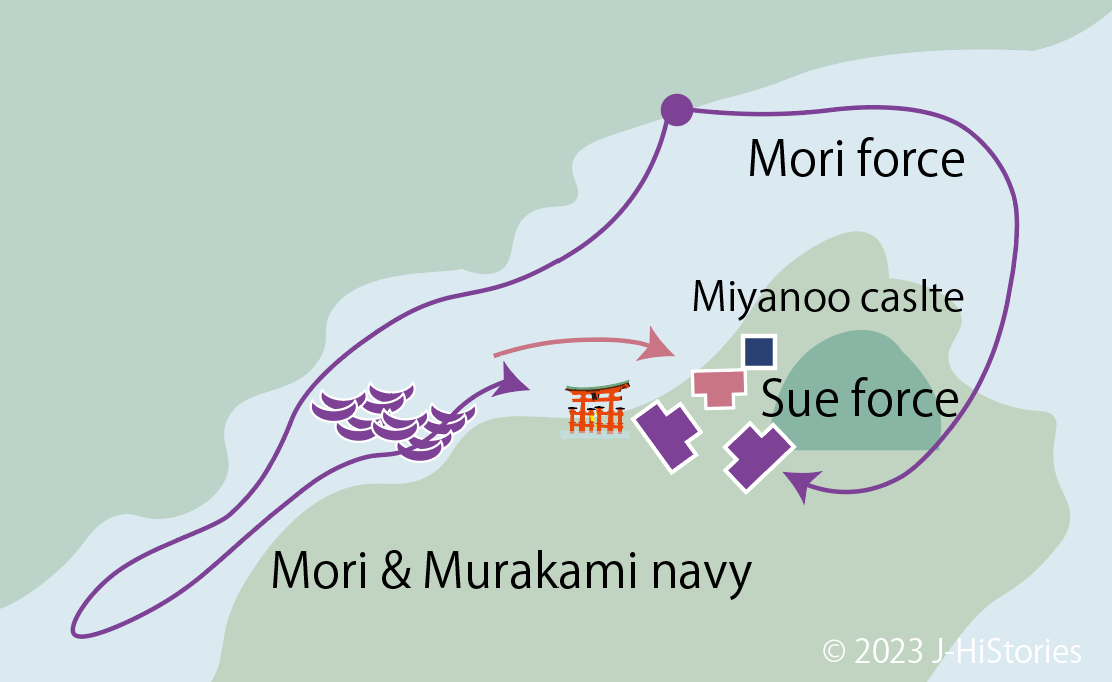
A Monarch of the Western Region with his Tough-as-nails Samurai spirit and intelligence
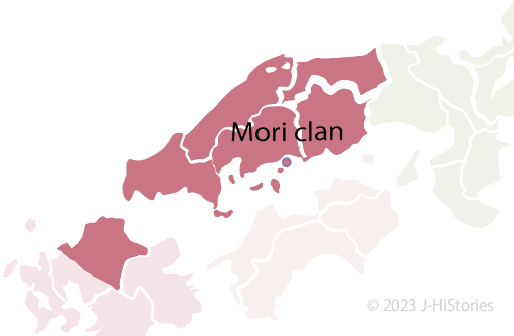
After that, Motonari won a decisive battle against the other powerful Amako clan and became the ruler of the western area of Japan in 1566 at age 70, which made Motonari attain the largest territory in western Japan five years before he passed away at age 75. His message to his remaining family was “Intelligence is the key to winning”. His father-in-law seemed to have informed him of a lot of intelligence as the local Ninja's boss. His tough-as-nails, along with Samurai spirit and intelligence, were well respected by other powerful federal lords. After Motonari’s death, the Mori clan’s feudal lord was taken over by his grandson Mori Terumoto (1553-1625, 毛利輝元) at the young age of 17. In the final chapter of the Sengoku period, he managed the largest fiefdom in the western part of Japan by fighting off and dealing with the powerful warlords such as Oda Nobunaga and Toyotomi Hideyoshi to solidify the foundation of the Mori family.
ltsukushima Deity Smiled on Motonari

The first samurai law enacted by the third regent of the Kamakura shogunate, "Goseibai-shikimoku" or Legal Code for the Warrior Class, stated that the majesty of Kami (deity) increases through the esteem of men, and men increase in fortune through the virtue of Kami. The scarlet glow of Itsukushima Kami may bring the blessing power to make Motonari the king of Western Japan. Motonari's military and intellectual prowess, combined with Itsukushima Kami's blessing, made his victory possible. We invite you to stroll through Miyajima Island and Itsukushima Shrine, contemplating Motonari’s military prowess and strategic brilliance.
Mori Motonari Timeline
| 1497 | Mori Motonari was born | Age=1 | Muromachi Period |
| 1523 | Motonari succeeded his father as the head of Mori clan | 27 | |
| 1525 | Motonari started to serve the Ouchi clan | 29 | |
| 1551 | Ouchi Yoshitaka, Motonari's lord, was defeated by Sue | 55 | |
| 1555 | Itsukushima Battle: Motonari won against Sue | 59 | |
| 1557 | Motonari defeated Ouchi clan and expaned his terittory | 61 | |
| 1562 | Motonari defeated Amako clan and expaned his terittory | 66 | |
| 1571 | Motonari passed away | 75 |
Recommendations to visit
- Access: 30 minutes from HR Hiroshima Station to Miyajimaguchi Station on the Sanyo Honsen Line. A 10-minute walk to Miyajimaguchi Port. Take the ferry to Miyajima Island. Then, a 10-minute walk to Itsukushima Shrine.

